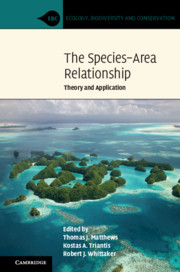Book contents
- The Species–Area Relationship
- Ecology, Biodiversity and Conservation
- The Species–Area Relationship
- Copyright page
- Contents
- Contributors
- Foreword
- Preface
- Part I Introduction and History
- Part II Diversity–Area Relationships: The Different Types and Underlying Factors
- Part III Theoretical Advances in Species–Area Relationship Research
- 7 Mathematical Expressions for the Species–Area Relationship and the Assumptions behind the Models
- 8 Biodiversity Scaling on a Continuous Plane: Geometric Underpinnings of the Nested Species–Area Relationship
- 9 Species Accumulation Curves and Extreme Value Theory
- 10 The Species–Area Relationship: Idiosyncratic or Produced by ‘Laws Acting around Us’?
- 11 The Species–Area Relationships of Ecological Neutral Theory
- 12 On the Interface of Food Webs and Spatial Ecology: The Trophic Dimension of Species–Area Relationships
- Part IV The Species–Area Relationship in Applied Ecology
- Part V Future Directions in Species–Area Relationship Research
- Index
- References
12 - On the Interface of Food Webs and Spatial Ecology: The Trophic Dimension of Species–Area Relationships
from Part III - Theoretical Advances in Species–Area Relationship Research
Published online by Cambridge University Press: 11 March 2021
- The Species–Area Relationship
- Ecology, Biodiversity and Conservation
- The Species–Area Relationship
- Copyright page
- Contents
- Contributors
- Foreword
- Preface
- Part I Introduction and History
- Part II Diversity–Area Relationships: The Different Types and Underlying Factors
- Part III Theoretical Advances in Species–Area Relationship Research
- 7 Mathematical Expressions for the Species–Area Relationship and the Assumptions behind the Models
- 8 Biodiversity Scaling on a Continuous Plane: Geometric Underpinnings of the Nested Species–Area Relationship
- 9 Species Accumulation Curves and Extreme Value Theory
- 10 The Species–Area Relationship: Idiosyncratic or Produced by ‘Laws Acting around Us’?
- 11 The Species–Area Relationships of Ecological Neutral Theory
- 12 On the Interface of Food Webs and Spatial Ecology: The Trophic Dimension of Species–Area Relationships
- Part IV The Species–Area Relationship in Applied Ecology
- Part V Future Directions in Species–Area Relationship Research
- Index
- References
Summary
We review trophic biogeography theory, a growing sub-discipline in ecology that seeks to merge food web ecology with the theory of island biogeography. We start by presenting a deliberately provocative theory, extending neutral community theory to multi-trophic systems, where one does not pay attention to the details of interactions across trophic levels, but rather emphasizes the consequences of traits associated with trophic rank, such as dispersal rates. Our results suggest that the effect of trophic rank on dispersal rates is a key driver of trophic rank effects on species–area relationships. We then examine effects of trophic specialization on species–area relationships, after which we turn to the implications of trophic generalization. An important arena of recent work is elucidating the impact of top down effects in food webs on species–area relationships. Lastly, we offer insights into key avenues for future research including the impact of cross-ecosystem subsidies in driving patterns of biodiversity in heterogeneous landscapes, the need to consider how species coexistence mechanisms may shift across islands or habitat patches varying in area and isolation, and assessing the evolutionary dimension of trophic influences on species–area relationships.
Keywords
- Type
- Chapter
- Information
- The Species–Area RelationshipTheory and Application, pp. 289 - 318Publisher: Cambridge University PressPrint publication year: 2021
References
- 1
- Cited by

